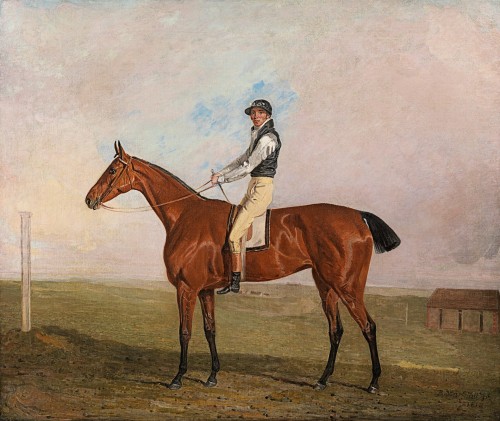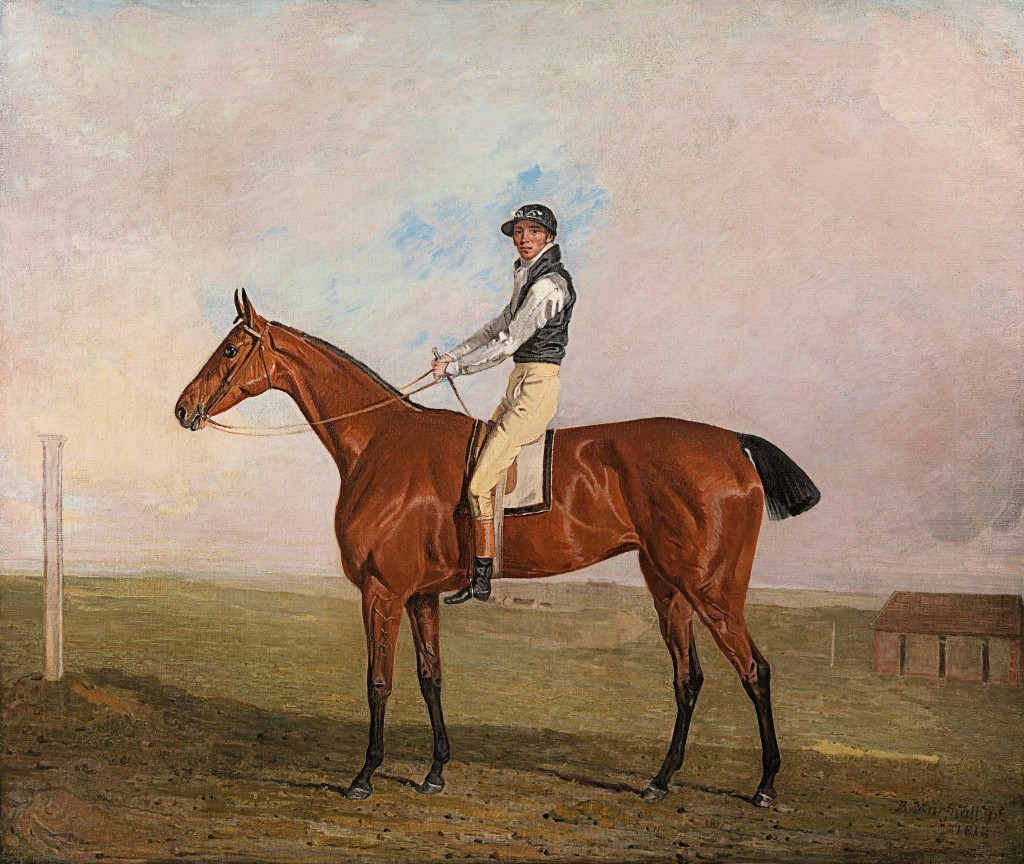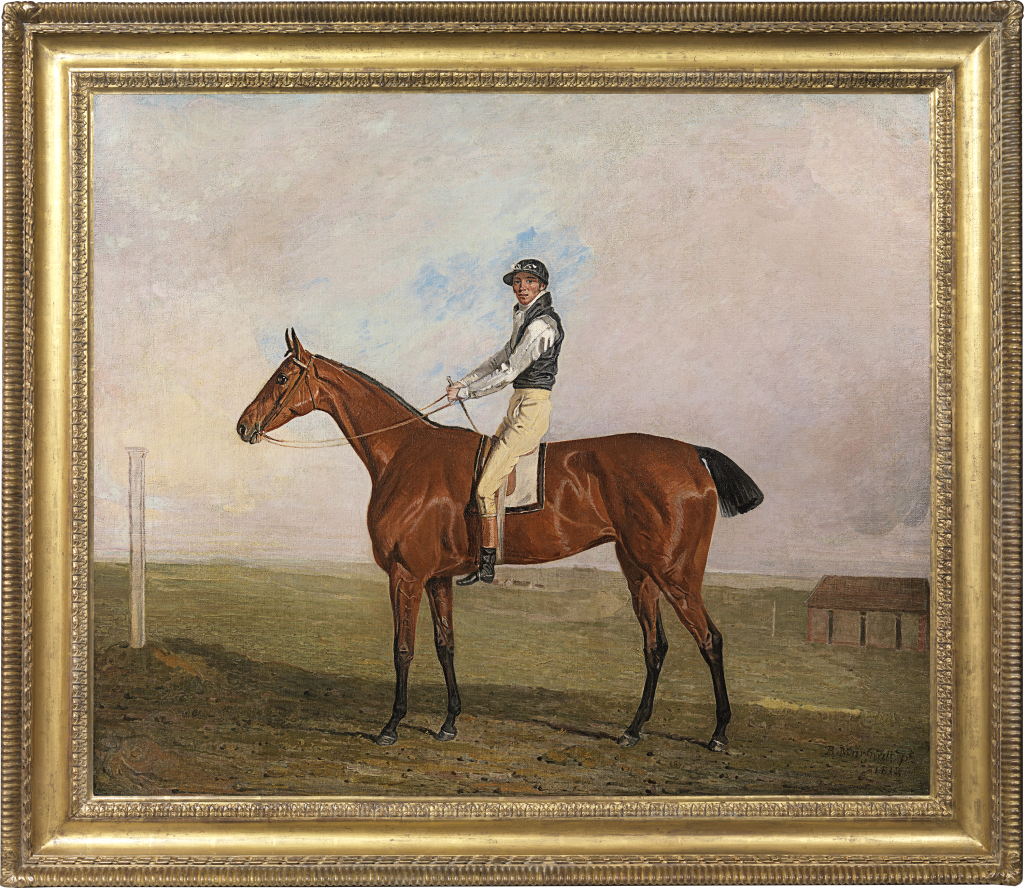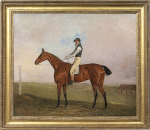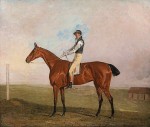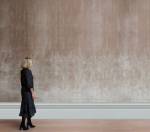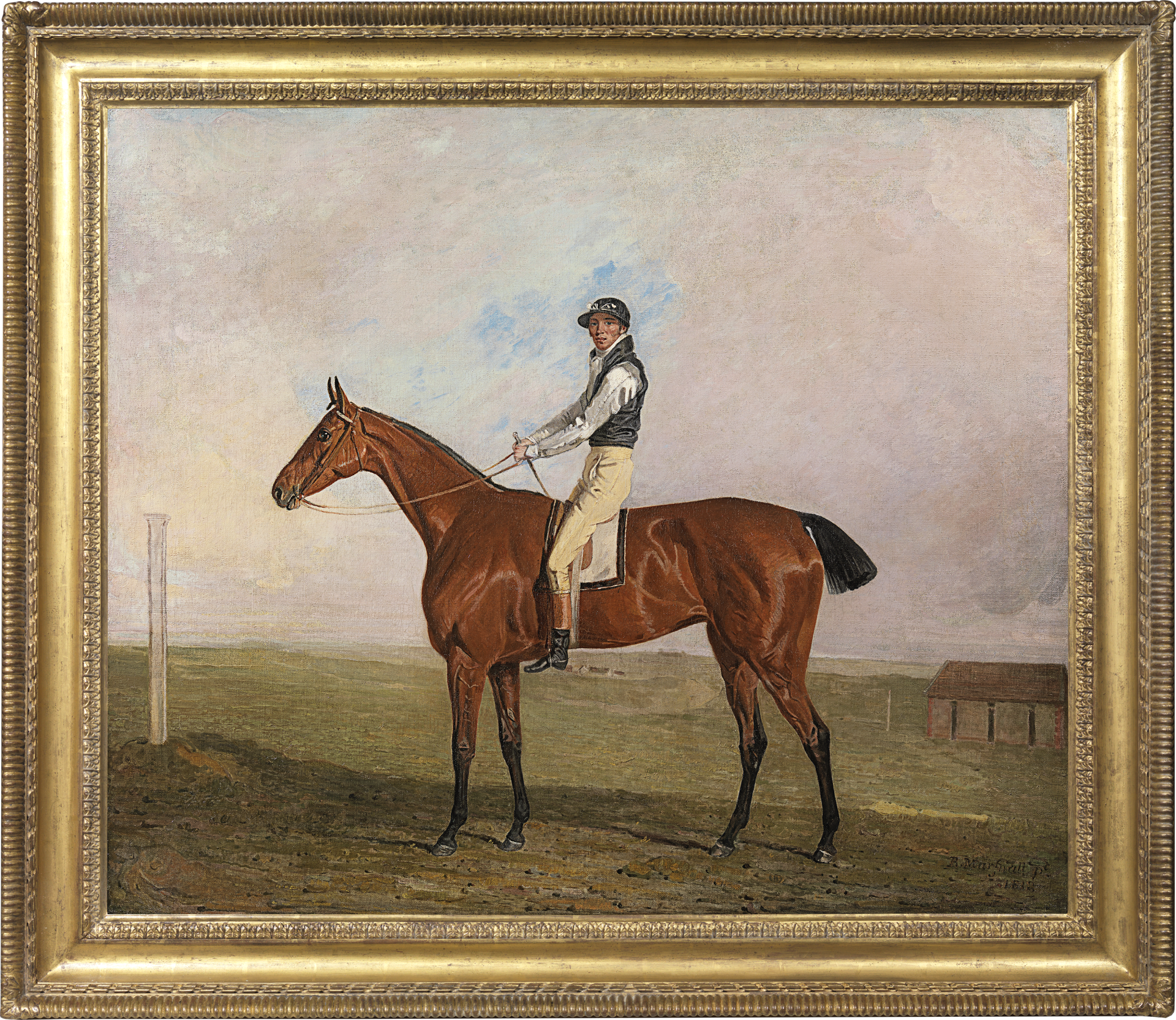BEN MARSHALL
Seagrave 1768 – 1835 London
Ref: CB 228
Mr Robert Jones’s bay racehorse Poulton with Sam Chifney Jnr up
Signed and dated lower right: B Marshall pt. 1818
Oil on canvas: 33 7/8 x 39 7/8 in / 86 x 101.3 cm
Frame size: 41 x 48 in / 104.1 x 121.9 cm
Provenance:
Commissioned by Robert Jones (1773-1834), Fonmon Castle, Glamorganshire;
by descent to Oliver Harris Valpy (1876-1914);
his sister Clara Valpy (1877-1969), who married Seymour William Brooke Boothby (1866-1951);
by descent in the Boothby family of Fonmon Castle, Vale of Glamorgan, Wales to Sir Brooke Boothby, 15th Bt. (b.1949)
Exhibited:
Cardiff, National Museum of Wales, 1951
Literature:
A Oswald, ‘Fonmon Castle, Glamorgan III: The Home of Sir Seymour Boothby, Bt., and Lady Boothby’, Country Life, vol. 105, no.2724, pp.736–737, no.8, illus.
J Steegman, A Survey of Portraits in Welsh Houses, vol. 2, Cardiff 1962, p.97, no.41
AD Fraser Jenkins, ‘The Paintings at Fonmon Castle’, in S Williams, Stewart Williams’ Glamorgan Historian, vol. 7, Glamorgan 1971, p.70, illus.
Ben Marshall was one of the finest sporting painters of the late eighteenth and first part of the nineteenth centuries. He not only brought out the physiognomy and personality of racehorses, but made sharply-observed portraits of the jockeys, owners and trainers in their orbit. By 1818, when this painting was made, Marshall was living near Newmarket, the better to indulge his love of racing and to ‘study the second animal in creation [the horse]…in all his grandeur, beauty and variety’[1]. It was also good for business, for Marshall had found that ‘a man would give me fifty guineas for painting his horse who thought ten too much to pay for the best portrait of a wife’[2].
Poulton, foaled in 1805 by Fanny out of Sir Peter Teazle, was bred by Mr Clifton. He was sold to Robert Jones (1773-1834) of Fonmon Castle and raced for him in 1811 and 1812. He ran six times in 1811, winning the Gold Cup at Oxford. After 1812 Poulton retired to stud at Fonmon. He was commemorated in a plate made circa 1817 by the local china company, Nantgarw (Nantgarw Chinaworks and Museum).
In Marshall’s painting Sam Chifney Jnr (1786-1854) is wearing Robert Jones’s colours. Chifney was one of the most celebrated jockeys of the first half of the nineteenth century, winning the Oaks five times, the Derby twice, the 2,000 Guineas in 1812 and the 1,000 Guineas in 1843, at the astonishing age of fifty-seven. The son of the famed (and notorious) jockey Sam Chifney Snr (c.1753-1807), like his father Sam Jnr was the retained jockey of the Prince of Wales, the future
George IV. Chifney Snr is credited with transforming racing ‘from a ritual slogging match, to a mounted chess game’[3]. His son rode with equal subtlety, employing the trademark family slack rein and the ‘Chifney rush’, holding his mount’s speed in reserve and cruising smoothly to victory in the final stages of a race.
This painting was commissioned by Poulton’s owner Robert Jones (1773-1834). The Jones family had acquired the twelfth century Fonmon Castle, Glamorganshire in 1654, when the Parliamentarian soldier Colonel Philip Jones (1618-1674) bought it from Sir Oliver St John. Jones, one of the richest men in Wales, survived the Restoration of the monarchy to become High Sheriff of Glamorgan in 1671. His great-grandson Robert Jones II (c.1706-1742) built up a fine collection of paintings from his Grand Tour in 1730 and was a friend of the Methodist preachers John and Charles Wesley. His son, the flamboyant (and eventually bankrupt) Robert Jones III remodelled parts of Fonmon in rococo style. The house passed into the Boothby family of Ashbourne, Derbyshire in 1932. Marshall’s painting descended in the family to Sir Brooke Boothby, 15th Bt. (b.1949).
BEN MARSHALL
Seagrave 1768 - 1835 London
Ben Marshall was the greatest horse portraitist to succeed George Stubbs. He painted racing, hunting and shooting scenes, boxing subjects, game cocks and portraits.
Marshall was born in Leicestershire, where he worked as a school master. He then moved to London and studied with the portrait painter Lemuel Francis Abbott. By the mid-1790s, Marshall had established his reputation as a leading sporting artist, enjoying patronage from the Prince of Wales and members of the aristocracy. His work was further publicised through The Sporting Magazine, which reproduced some sixty of his paintings between 1796 and 1832.
In 1812, Marshall moved to Newmarket, an area in which he found ‘many a man who will pay me fifty guineas for painting his horse, who thinks ten guineas too much for painting his wife’. Unfortunately, he had a severe coaching accident in 1819, and suffered from temporary paralysis. He turned to sporting journalism and became a correspondent for The Sporting Magazine, writing under the pseudonyms of Observator and Breeder of Coctails. In 1825, he returned to London, where he remained for the rest of his life.
[1] Sporting Magazine, September 1826, p.318, quoted in David Fuller, ‘Marshall, Benjamin (1768-1835)’, Oxford Dictionary of National Biography, Oxford 2004.
[2] Sporting Magazine, January 1828, p.172, quoted in Fuller, op. cit.
[3] Michael Tanner and Gerry Cranham, Great Jockeys of the Flat, London 1992, p.20.

